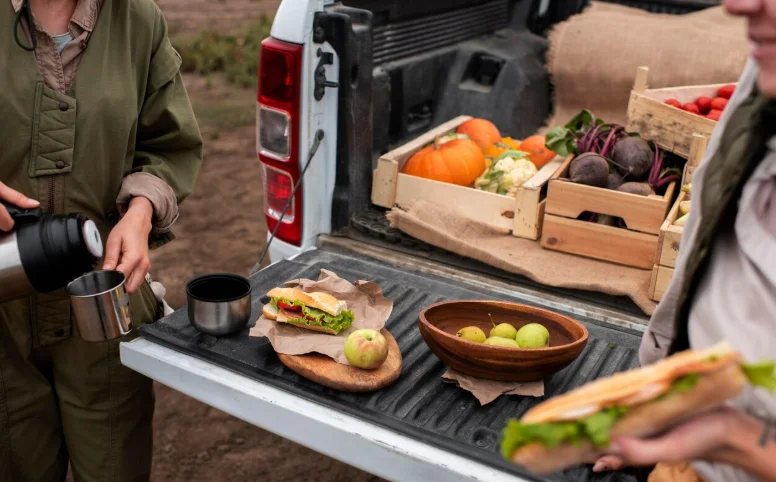Why Every Traveler Needs a Travel Kitchen Setup
Traveling doesn’t mean giving up healthy, home-cooked meals. A travel kitchen lets you cook anywhere—whether you’re camping, road-tripping, or staying in an Airbnb. It offers more than just convenience. It gives you control over your meals, saves money, and helps meet dietary needs with ease. Relying solely on restaurants can be limiting and costly. But with a portable kitchen, your options multiply.
A well-planned travel kitchen lets you prepare simple snacks or full meals without stress. Whether you’re traveling solo, with family, or as a digital nomad, having a cooking setup gives you more freedom. You’re no longer tied to restaurant hours or local menus. You eat what you want, when you want.
Essential Travel Kitchen Gear for Every Journey
Before building your mobile kitchen, start with the basics. The right tools make a huge difference in meal prep.
Cooking Equipment
First, get a portable stove either gas or electric. Gas stoves are ideal for camping, while electric ones work well in indoor setups. Many travelers also prefer compact induction cookers due to their safety and speed. Carry a non-stick pot and frying pan. These two items are enough for boiling, frying, and sautéing.
Include a collapsible kettle or travel-sized electric kettle. This helps with coffee, tea, and boiling water for instant foods. Don’t forget cooking utensils like a spatula, ladle, and serving spoon. A cutting board and sharp knife are non-negotiables. Choose foldable or travel-specific versions to save space.
Eating Utensils and Dinnerware
Pack lightweight, reusable plates, bowls, and cutlery. Collapsible bowls and silicone cups save space. Stainless steel or bamboo options are sturdy and eco-friendly. Bring an insulated mug or flask to keep drinks hot or cold during your adventures.
Small but Vital Tools
The small stuff often makes the biggest difference. Always include a can opener, peeler, grater, and measuring cups. A kitchen thermometer is useful if you’re cooking meat. Bring kitchen scissors, zip bags, and a roll of aluminum foil. These tools will serve multiple purposes and are often overlooked.
Smart Food Storage for Travelers
Storage is essential to keep your mobile kitchen clean and efficient. Use stackable food containers for dry goods. Label them to avoid mix-ups. Bring resealable silicone bags for snacks, vegetables, or leftovers. These are eco-friendly and take up less space than plastic containers.
Consider a soft cooler bag or a portable mini fridge for perishable items. If you’re staying somewhere for a few days, a mini fridge with a 12V car adapter works well. Keep dry foods separate from perishables to prevent contamination.
Use a hanging organizer or a travel kitchen box to keep your tools in order. Having specific compartments for utensils, cookware, and food makes cooking easier. A tidy kitchen is a functional kitchen.
Best Shelf-Stable Foods to Pack in a Travel Kitchen
Choosing the right ingredients is just as important as packing the right tools. Stock your travel kitchen with non-perishable, shelf-stable foods that can be used in multiple recipes.
Dry grains: rice, pasta, couscous, quinoa, instant oats
Canned goods: beans, tuna, corn, chickpeas, tomatoes
Condiments and spices: salt, pepper, olive oil, soy sauce, chili flakes, garlic powder
Snacks: trail mix, dried fruit, protein bars, crackers
Others: peanut butter, powdered milk, instant coffee, tea bags
These items don’t require refrigeration and are ideal for quick meals or snacks. Combine them creatively to make a variety of dishes with minimal effort.
Cooking While Traveling: Safety and Hygiene Tips
Safety is essential when cooking on the go. Always cook in ventilated areas, especially when using gas burners. Avoid using open flames inside tents or vehicles. Keep a small fire extinguisher or fire blanket on hand when using heat sources.
Practice proper food hygiene. Wash fruits and vegetables before use. Wipe surfaces before and after cooking. Separate raw and cooked foods. Always wash utensils with biodegradable soap and dry them before storing.
Dispose of food waste properly. Use sealable garbage bags or compostable waste bins. Never leave food out in nature or public spaces, as it can attract wildlife or pests.
How to Organize a Travel Kitchen in Small Spaces
If you’re traveling in a car, campervan, or small space, smart organization is key. Use drawer dividers or packing cubes to group items. Store flat items like cutting boards and lids vertically. Hang utensils using magnetic strips or adhesive hooks. Store spices in labeled mini containers or stackable spice jars.
Use a collapsible sink or wash basin to clean dishes. Keep a drying rack that folds flat. Use under-seat storage or roof storage boxes to store non-daily kitchen items. Evaluate your setup after each trip to adjust what you actually use.
Meal Ideas You Can Cook With a Travel Kitchen
With the right gear and ingredients, you can cook delicious meals even on the road. Here are a few simple but satisfying ideas:
One-pot pasta with canned tomatoes, garlic, and spices
Stir-fried rice or noodles with canned veggies and soy sauce
Tuna wraps with crackers and mayo
Oatmeal breakfast bowls with dried fruit and honey
Grilled cheese sandwiches with tomato soup
Pan-fried eggs with toast and instant coffee
Stick to meals that require one or two pans and minimal clean-up. Focus on nutrition, speed, and versatility.
Best Travel Kitchen Tips for Campers and Van Lifers
Campers and van lifers face unique challenges. Every inch counts. Choose multi-use items like a pot lid that doubles as a plate. Use vertical space for hanging tools. Add removable hooks, magnetic racks, or even a small fold-out prep table.
Install a compact water tank and hand pump faucet for easier cleaning. A solar oven is an excellent eco-friendly tool for off-grid cooking. For long-term trips, consider adding a portable propane stove with refillable tanks.
Always reassess your kitchen setup after a few trips. Remove unnecessary tools and replace them with more compact options. Simplicity is the key to efficiency.
Final Thoughts: Build a Travel Kitchen That Works for You
A travel kitchen gives you more than just the ability to cook. It gives you independence, healthier options, and a deeper travel experience. Eating out every day drains your budget and limits your options. A mobile kitchen lets you eat on your schedule and cook meals you actually enjoy.
With smart tools, careful organization, and the right ingredients, your travel kitchen can be as functional as your home kitchen. It’s not about cooking gourmet meals it’s about making everyday meals possible, even in unfamiliar places. Start small, adjust as you go, and create a setup that fits your style of travel. Once you get used to it, you won’t travel without your kitchen again.










